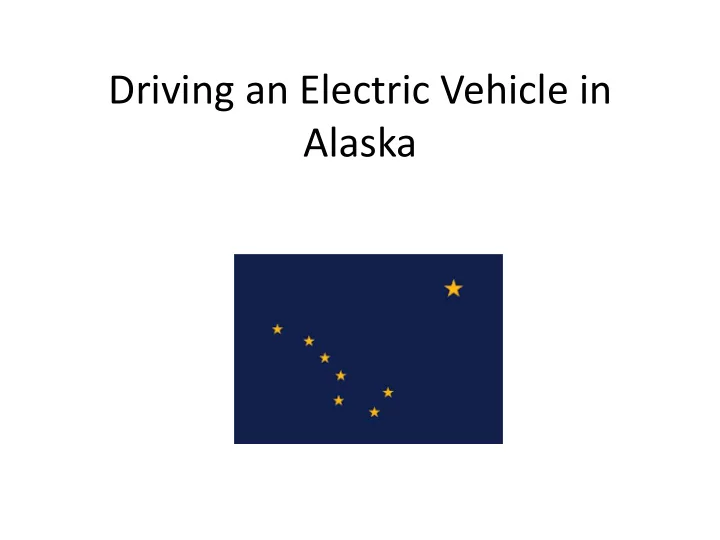

Driving an Electric Vehicle in Alaska
#1: How does it do in winter ? Ice/ Snow Handling Heavy • Low center of gravity • All wheel drive, Blizzak • =Great handling • Cold Comfort iPhone heater control • Instant on heater • Guilt-free “idling” • - Heater = battery drain Regenerative Braking Reduced when battery is cold • Most comfortable winter car I’ve ever owned.
#2: How does cold affect range ? FBX Healy Data for Chevy Bolt
#3: Where do you charge? • At home. 99.99% of time • For longer range EVs, charging around Anchorage is never needed. • 240V level 2 charging charges at ~30 miles of range/hour • 115V outlet – 4 miles/hour
Charging – Anchorage 2018
Charging – Anchorage 2020
Charging - Southcentral
#4: How about Range Anxiety
Range Anxiety • Concern that the battery will go flat before you reach your destination. • Due to few charging stations. • Not generally a concern during daily driving; (unless you forgot to plug in L ). • Diminishes as you learn how far you can go under different conditions. • Will go away when chargers are as common as gas stations.
Road Trip to Homer
Denali to Eagle River
Adventure Denali Charging
Why an EV in AK ? • Maintenance Costs • 2¢/mile ICV vs. 0.6¢/mile EV • If time is money…. I love NOT going to the gas station! • Just hit 62,000 miles. Oil change? What oil change? • Operating Cost – 10-25¢/mile for ICV vs 4-6¢/mile for EV • Comfortable and safe driving in winter • EV ownership reduces electricity rates for everyone. • Superior driving experience. • Reduced or zero CO2 emissions.
CO2 Emissions
Cost of Ownership
Maintenance
Battery Degradation
Vehicle to Grid • Use EV battery for grid power storage • Routine usage or emergency power • Routine usage not needed unless time-of-use electric rates are in place – Expensive, optimized vehicle battery would degrade faster – Competes with Teslas residential battery • Emergency backup power – No technical reason it couldn’t work – Require control system to backfeed power along with inverter to create AC power
Industry Trends • Charging Speeds – Latest Tesla V3 Supercharger. 75 miles of range in 5 minutes. 180 miles of range in 15 minutes. • Range – Current Tesla Model S 340 or 390 mile range • Costs – Tesla Model 3: 250 mile range. $39K – Chevy Bolt: 260 mile range. $37K
Recommend
More recommend